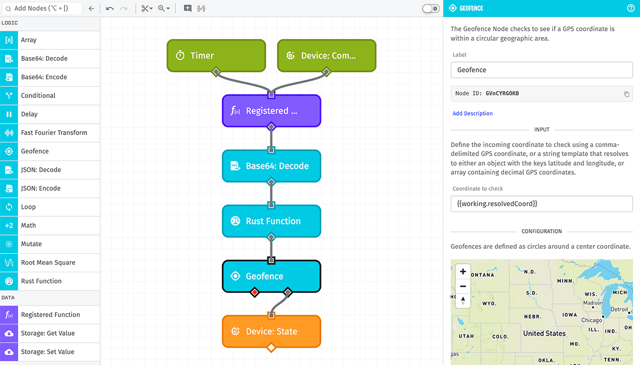Today’s product update extends the functionality of the Embedded Edge Agent through a series of new workflow nodes. The nodes make it easier for experienced developers to work within the agent; for non-experienced developers to execute common operations; and for product designers to utilize the EEA in additional use cases.

Rust Function Node
First, this update includes a Rust Function Node, which allows experienced programmers a means for writing custom code to execute within the Embedded Edge Agent. Most of the nodes available within Embedded Workflows are written in Rust (which then compiles down to WebAssembly), so exposing the ability to write Rust code to workflow developers was a natural next step.
In our cloud environment and within the Gateway Edge Agent, Losant has provided a JavaScript Function Node since our platform’s initial launch. In addition to allowing programmers a means for writing code within a workflow, the JavaScript Function Node also allowed Losant’s developers to see the common payload manipulations users were performing, which in turn led to the development of some easier to use nodes such as the Array Node, the Object Node, and the String Node.
Our goals for the Rust Function Node are the same: Provide the flexibility that programmers seek while learning how we can make our platform easier for everyday users.
Base64 Encode & Decode Nodes
Shortly before we launched the Embedded Edge Agent, we identified Base64 Encode and Base64 Decode Nodes as two nodes that we wanted to immediately add to the palette. Our first tutorials utilized the Registered Function Node to bring Base64 encoding into those flows, but knowing it would be a fairly common function used across multiple use cases made these nodes prime candidates for inclusion in the palette.
Geofence Node
While not a new node – in that we already support a Geofence Node in our other workflow classes – we extended the EEA to bring this node to Embedded Workflows. We’ve already had some users approach us about integrating the Embedded Edge Agent into location-dependant use cases, which made the Geofence Node a prime candidate for our slate of post-launch additions.
Other Updates
As always, this release comes with a number of smaller feature improvements, including:
- We’ve published a new Jupyter Notebook image that supports format version 4.5, as well as a handful of new client-requested libraries.
- Organization administrators can now see if the members of their organization have enabled two-factor authentication on their Losant accounts (or if they utilize single sign-on). Instance administrators also have access to this information about child organization members and other instance members.
- The Fast Fourier Transform Node now allows for rounding the individual result values to a specified decimal place. This helps keep the size of MQTT messages down and can also make for easier parsing when analyzing the results of the FFT calculation.
What’s Next?
With every new release, we listen to your feedback. By combining your suggestions with our roadmap, we can continue to improve the platform while maintaining its ease of use. Let us know what you think in the Losant Forums.
